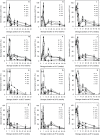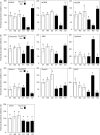Fluctuation of Arabidopsis seed dormancy with relative humidity and temperature during dry storage
- PMID: 26428064
- PMCID: PMC4682427
- DOI: 10.1093/jxb/erv439
Fluctuation of Arabidopsis seed dormancy with relative humidity and temperature during dry storage
Abstract
The changes in germination potential of freshly harvested seeds of Arabidopsis thaliana stored in various combinations of temperature and relative humidity were investigated over 63 weeks of storage. Seeds of the wild type Col-0 and of two mutants displaying low and high levels of dormancy, cat2-1 and mtr4-1, respectively, were stored at harvest in 24 different environments including a combination of eight relative humidities, from 1 to 85%, and four temperatures (10, 15, 20, and 25 °C). These mutations did not influence behaviour of seeds during storage. Primary dormant seeds did not germinate in darkness at 25 °C but acquired the potential to germinate at this temperature within 7 weeks when stored in relative humidities close to 50% across all temperatures. Sorption isotherms and Arrhenius plots demonstrated that the seed moisture content of 0.06 g H2O/g dry weight was a critical value below which dormancy release was associated with reactions of negative activation energy and above which dormancy release increased with temperature. Longer storage times when relative humidity did not exceed 75-85% led to decreased germination at 25 °C, corresponding to the induction of secondary dormancy. Dormancy release and induction of secondary dormancy in the dry state were associated with induction or repression of key genes related to abscisic acid and gibberellins biosynthesis and signalling pathways. In high relative humidity, prolonged storage of seeds induced ageing and progressive loss of viability, but this was not related to the initial level of dormancy.
Keywords: After-ripening; Arabidopsis thaliana; ageing; germination; relative humidity; temperature..
© The Author 2015. Published by Oxford University Press on behalf of the Society for Experimental Biology.
Figures





References
-
- Auge GA, Blair LK, Burghardt LT, Coughlan J, Edwards B, Leverett LD, Donohue K. 2015. Secondary dormancy dynamics depends on primary dormancy status in Arabidopsis thaliana. Seed Science Research 25, 230–246.
-
- Bailly C, Leymarie J, Lehner A, Rousseau S, Côme D, Corbineau F. 2004. Catalase activity and expression in developing sunflower seeds as related to drying. Journal of Experimental Botany 55, 475–483. - PubMed
-
- Bailly C, El-Maarouf-Bouteau H, Corbineau F. 2008. From intracellular signaling networks to cell death: the dual role of reactive oxygen species in seed physiology. Comptes Rendus Biologies 331, 806–814. - PubMed
-
- Baskin CC, Baskin JM. 1998. Seeds: ecology, biogeography, and evolution of dormancy and germination . Academic Press: San Diego, CA.
MeSH terms
LinkOut - more resources
Full Text Sources
Other Literature Sources

